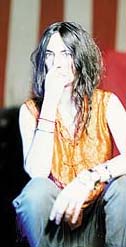
Comment
on this story
Who:
Patti Smith
When:
Friday, July 28 at 8:30 p.m.
Where:
Bijou Theatre
Ticket Info:
$20.50 at Tickets Unlimited Outlets or 656-4444 to charge by phone.
|
|

A punk expounds on one of his most stirring influences
by John Sewell
I remember way back in the late '70s, there was a lot of mainstream media coverage of the burgeoning punk scene. It seemed that every time you'd turn on the evening news on one of the big three networks, there was some kind of story about the pernicious spread of evil that was occurring in England and New York. It was as if the news media were playing Minuteman, warning the U.S. populace about the ensuing decadence that would destroy everything decent in society. The old guard (the '60s peace and love generation) was totally shaken by the new crop of rockers who were sick and tired of passivity, sensitivity, and the complacent, granola-fed, California hippie worldview.
One morning in the summer of '77, I happened on some punk rock coverage on NBC's Today show. Barbara Walters (of all people) was interviewing punk priestess Patti Smith and I was all hopped up to see some female hellion with spiky hair and safety pins tear into old Barb, swearing and spitting. Needless to say, I was a little bit disappointed.
Sure, Patti looked disheveled and gaunt, but she didn't deliver what I had expected from a "punk." Instead, she was polite and articulate, talking about expression and creativity instead of anarchy. She described herself as an artist, telling Walters that an artist was a person who could go over the edge of madness in their expression, yet return to sanity in their day-to-day life. I was befuddled.
In retrospect, it's obvious that Smith's ability to traverse the boundaries of sanity in her art and return to normalcy has served her well. She's managed to have a strong family life, stay healthy and sane and continue to produce engaging music. Instead of constantly rehashing her past and becoming a caricature in the process, Patti has valiantly forged on into adulthood—creating mature music that transcends age boundaries.
An overview of Patti's life and work is rife with juxtaposition. When Smith first came to national acclaim she was perceived as a rebel, yet she was actually a link in a long chain of performers and writers of the avant garde. Smith combined the deviltry of the Rolling Stones with the literary tradition of the beat generation. She was a '70s rebel, yet she had plenty of '60s idealism (think Chicago riots circa '68, not the San Francisco Summer of Love). Patti's tough, reptilian image was an affront to standard ideas of femininity and beauty, yet she has become a role model and archetype for countless subsequent female performers. Once regarded as an upstart and iconoclast, Smith has now found her place among the most revered artists of the rock 'n' roll tradition.
Finding success in the music world didn't come easy for Smith early on; and perhaps that's a key to the depth and maturity of her work. Smith moved to New York City around 1969, quickly finding friends among the Max's Kansas City/Warhol crowd. In this era, Patti shared an apartment with photographer Robert Mapplethorpe, co-wrote the play Cowboy Mouth with Sam Shepard, and was a music journalist. She began a long-lasting collaboration with guitarist Lenny Kaye in the early '70s, performing poetry with his sole accompaniment. By the time of her first full-length album release, Smith was almost 30 years old and an established presence on the New York art/performance/rock music scene.
Musically, Smith was most prolific from 1975 to 1979. In this period, The Patti Smith group (PSG) produced four classic albums (Horses, Radio Ethiopia, Easter, and Wave), toured the world several times over, and reaped her highest album sales. She even managed to score a semi-hit with Easter's "Because The Night," co-written with Bruce Springsteen (and later covered by Natalie Merchant). But just as Patti was coming closest to mainstream success, she pulled back and went into a career hiatus for almost a decade.
After a final tour in support of Wave, Smith married former MC5 guitarist Fred "Sonic" Smith, then retreated to Detroit, where the two would raise a family. Supposedly, home and family life suited her quite well. She didn't record another album until 1988's Dream of Life, even then only making rare concert appearances.
Tragedy fell upon the Smith household in the early '90s when Fred "Sonic" Smith died of cancer, an event that provided source material for the reflective and mournful Gone Again album. Gone Again also reunited Smith with original PSG members Lenny Kaye and Jay Dee Daugherty. She has since released two albums, Peace and Noise and, most recently, Gung Ho, whichseems an apt title for PSG Mach II. Once again, the band is performing worldwide and cranking out top-notch music.
As good as the recordings are, Patti Smith is best experienced live. In her performances, drama, literature, poetry, and music is blurred into a seamless whole. A Patti Smith concert is both purgative and revelatory. Her onstage persona is reminiscent of Jim Morrison and Iggy Pop, yet her deep alto voice is a unique instrument unto itself.
Patti Smith figures prominently in any retrospective of the early days of New York punk, but she has never been a nihilist. Patti was punk because she did things her own way instead of conforming to the pre-existing notions of what was an acceptable woman's role in rock 'n' roll—all the while producing exciting music and stirring, eloquent lyrics.
Perhaps this all seems like excessive praise but Patti Smith has carved her own unique niche in rock music—fully incorporating several disciplines into a body of work that is truly art. What this all boils down to is great music, and that is Ms. Smith's forte.

July 27, 2000 * Vol. 10, No. 30
© 2000 Metro Pulse
|





